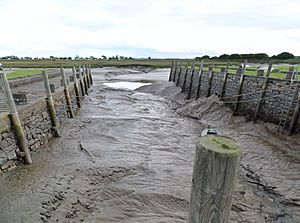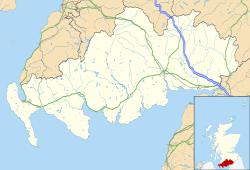Wigtown Harbour facts for kids
Quick facts for kids Wigtown Harbour |
|
|---|---|
| Wigtown, Scotland GB |
|

Wigtown Harbour basin
|
|
| Coordinates | 54°51′44″N 4°26′04″W / 54.862170°N 4.434535°W |
Wigtown Harbour or Wigtown Quay is a historic port located in Wigtown, Dumfries and Galloway, Scotland. It was built in 1818 to help ships reach the town, as the older harbour had become too shallow. This happened because mud and sand, called 'silt', built up over many years in the River Bladnoch and Wigtown Bay. The harbour was important for trade and connecting Wigtown to other places.
Contents
What is Wigtown Harbour?
The new harbour was built south of Wigtown in 1818. It had a long wall along the river, called a quay, made of stones and wood. There was also a small, square basin where ships could dock. This design was simple, offering places for ships to tie up rather than protecting them from bad weather. A road, Harbour Road, connects the quay to the town.
A Brief History of Wigtown Harbour
Early Days and the Old Harbour
From the 1400s, the original Wigtown Harbour was located near St Machute's Church. It was the starting point for a ferry that crossed the River Cree and Wigtown Bay to Creetown. This old harbour was very important for travel and trade in the area.
Why a New Harbour Was Needed
Over time, the River Bladnoch and Wigtown Bay started to fill up with silt. This made it harder for ships to sail to Wigtown. By the 1600s, the problem was already noticeable. Because of this, a new harbour was built in 1818 to the south of the town.
The New Harbour's Life
The new harbour worked for many years, but by the mid-1900s, it was no longer used. It was officially recorded as disused in 1976. However, in the mid-1980s, the harbour was repaired and improved. Even after these improvements, it has become heavily silted again.
Wigtown Castle's Role
Long ago, Wigtown Castle stood near the original path of the River Bladnoch. The castle helped protect the area from attacks by English forces coming across the Solway Firth.
How the Harbour Worked
Ships and Goods
The harbour was designed to handle ships as large as 300 tons. The main goods brought in were lime, coal, and manure, which were important for farming. The main export from Wigtown was farm produce. Herring fishing was not a big activity here.
Trade Over the Years
- Between 1845 and 1849, sailing ships carried 3892 tons of goods.
- In 1856, 54 ships carried 2080 tons.
- By 1875, 40 ships carried 1931 tons.
- In 1884, 35 ships carried 1466 tons.
Interestingly, there are no records of steamships visiting Wigtown during these years.
Customs House
Wigtown once had a customs house. This building was used to check goods coming in and out of Wigtown Harbour. It also monitored trade in nearby areas like Kirkcudbright and Wigtownshire.
Keeping the Harbour Clear
Old maps from the 1850s show a special system at the harbour. There was a self-acting sluice and two other sluices connected to a water channel. This system was likely used to clean out the silt. Water would be stored behind a gate (sluice) and then released quickly to wash away the mud, much like a system used at Kingholm Quay on the River Nith.
Wigtown Harbour Today
Restoration and Access
Significant repair work was done in the 1980s to improve the harbour. While the harbour basin has filled with silt again, ships can still dock there. Two slipways provide easy access to the river for smaller boats.
For Visitors
Today, there are information boards that tell visitors about the harbour's history. The car park on the quay is used by people visiting a bird watching hide. This hide offers great views across the large areas of salt marsh. These marshes are protected as a Local Nature Reserve (LNR). In 2004, the first pair of ospreys in over 100 years returned to Galloway and nested here, making it a special place for nature lovers.


